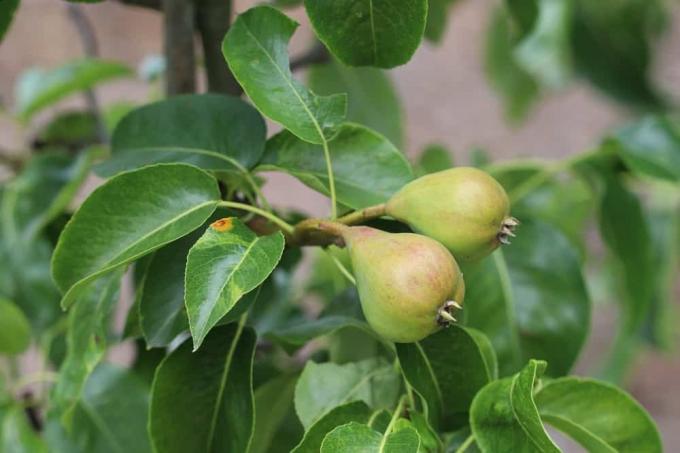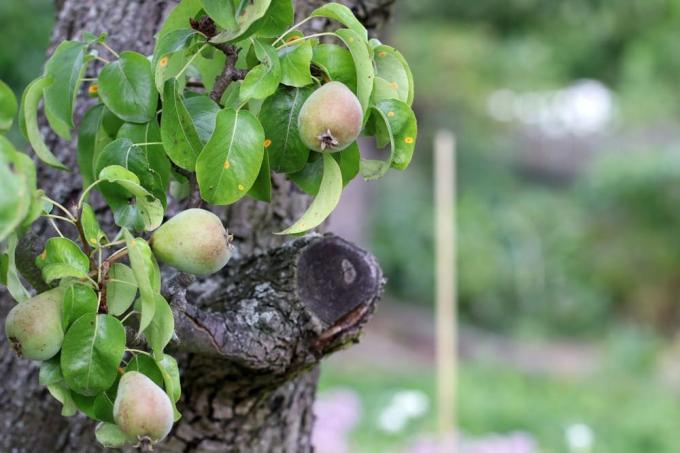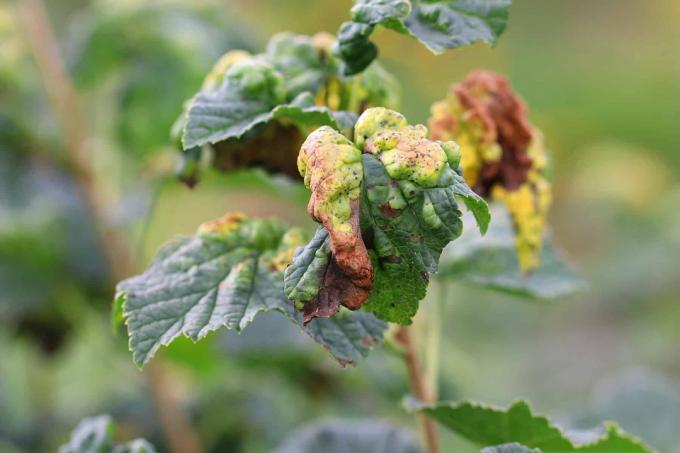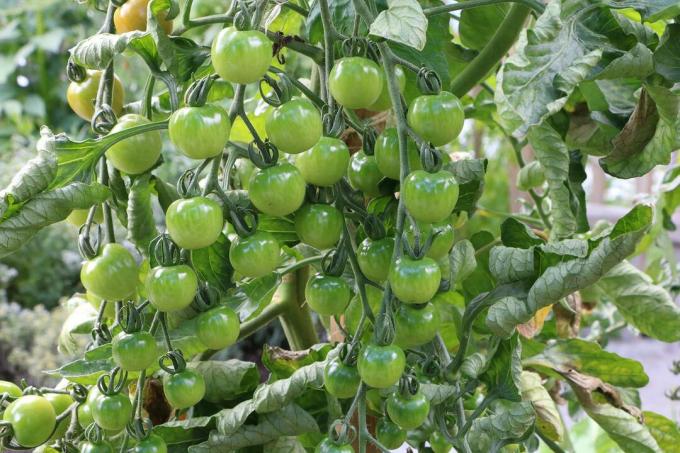

Table of contents
- Pear lattice rust infection chain
- Prevent
- treat intermediate host
- Remove intermediate host
- replace intermediate host
- plant strengthener
- reduce nitrogen
- remove leaves
- spray
Pear rust is a fungus from the order of rust fungi that affects plants of the species Pyrus (pears) and Juniperus (juniper). A unique feature of the fungus is the annual change of host, because juniper plants are attacked over the winter, while pears are at the mercy of pear rust in summer. To get rid of the fungus, special sprays are available that work effectively against the infection.
Pear lattice rust infection chain
Pear rust (Gymnosporangium fuscum) is a fungal disease that follows a unique course throughout the year, during which it undergoes multiple host changes. This course is called an infection chain, which describes exactly which plant species are attacked by the rust fungus and when:
- Winter to early spring: the juniper species Juniperus chinensis (Chinese juniper) and Juniperus sabina (Sade tree), rare Juniperus scopulorum (Rocky Mountain juniper)
- Spring to early autumn: pear trees (bot. Pyrus), rare quinces (bot. Cydonia oblonga)
The spores specifically attack the juniper trees and shrubs of the species mentioned and spread in them. The infection manifests itself in knotty branch thickening and large spore deposits. These are as follows:
- Color orange
- Consistency: gummy, bilious
- protrude in individual thickenings
- become slimy over the year
The spores of Gymnosporangium fuscum are easy to spot and through these the fungus infects its next target, pear trees. Interestingly, the juniper plants are not damaged by the fungus, they only serve as a kind of intermediate host. Basidiospores are formed, which are distributed by winds in a radius of 500 meters from spring and settle on the leaves of the pear trees. There they begin to infect the pear and thus continue the chain of infection:
- The upper side of the leaf becomes blotchy
- Spots are orange-reddish
- Spots get bigger over the months
- Summer spores are formed, which attack the tree even more
- now pollinating insects like bees are attracted by the formation of a false nectar
- the spores cling to the animals and carry them on
- in late summer the fungus spreads to the underside of the leaves
- oval, brownish spore beds up to 1.5 centimeters in size are formed
- these rupture at the beginning of winter and spores are released which in turn infest juniper plants

Through this chain of infection, the rust fungus can easily sustain itself and use every season to its advantage. This development must be taken into account when combating pear rust, as this is the only way to effectively combat the infestation. The growth of young pear trees in particular can be severely restricted by the rust fungus, while older specimens are only weakened. The consequence of this is often stunted growth that intensifies over the years, resulting in a poor harvest. However, do not confuse the infestation with the fungus with the pear pox mite, which has a similar pattern of damage but without the spore deposits.
Tip:
Even if your pear is covered in pear rust from top to bottom, you shouldn't just throw the fruit away after harvest. The fungus affects only the leaves of the tree and not the fruit, which can still be eaten and pose no threat to your health.
Prevent
Combating pear rust after infestation of pear trees is extremely tedious and difficult, so you should contain a possible infestation as early as possible. If the chain of infection described above is broken, the spores will not be able to identify the trees and your pears will be safe without much effort. There are different methods of prevention:
treat intermediate host
In order to prevent the spores from spreading further, it is necessary to contain the infestation and prevent the spores from taking to the skies again from spring onwards. For this reason, as soon as you have a juniper of the species mentioned above in your garden, you should check it for the fungus. If this shows the characteristic growths, you should thoroughly remove all affected areas. Simply remove them with a clean pruning shears or pruning shears.
Remove intermediate host
The complete disposal of the host is extremely effective, especially if it is heavily infested. If the affected juniper is removed from the immediate vicinity of the pears, the infection can be largely contained. But always make sure that even distant junipers can still spread their spores, therefore it is possible to remove the pear tree as well, so that the spores no longer spread over the summer host multiply.
replace intermediate host
If you do not want to do without a juniper in the garden, you should choose another species that is not susceptible to the rust fungus. This includes:
- Municipality of Wacholder (bot. Juniperus communis)
- Gray juniper (bot. Juniperus media 'Hetzii')
- Sea juniper (bot. Juniperus conferta)
- Virginia juniper (bot. Juniperus virginiana)
- Scaled juniper (bot. Juniperus squamata)
- Creeping juniper (bot. Juniperus horizontalis)
Alternatively, you can also choose pear varieties that are not as susceptible to the fungus:
- condo
- Countess of Paris
- Stuttgart goat herd
- Upper Austrian wine pear
- Trevoux
- Gellerts
Although these pear varieties could still be affected by pear rust, they are much more resistant to Gymnosporangium fuscum and therefore take longer to become infected. Of course, replacing the juniper species is more effective.
plant strengthener
It is advisable to treat pears with plant strengtheners as soon as the leaves sprout in spring. Horsetail extract, which you can purchase from manufacturers such as Neudorff or Aries, is best suited for this. If you want to make the extract yourself, you can do that too. This home remedy is the only one that works effectively to prevent pear rust:
- Ingredients: 10 g dried or 100 g fresh field horsetail (bot. Equisetum arvense) per 1 liter of water
- cut the blades of grass into small pieces
- put them in a pot of water
- Soak for 24 hours
- then boil for 30 minutes
- then pour through a sieve into another container
- mix the decoction with water in a ratio of 1:5

The finished extract can be stored properly for several months. Spray the pear trees with these four times at intervals of one to two weeks.
reduce nitrogen
Use fewer fertilizers that contain a lot of nitrogen. These weaken the pears for a long time, thereby enabling an infection that strikes faster and leaves the trees vulnerable to the fungi.
remove leaves
If your pear tree has been attacked by the fungi, you should remove all leaves as soon as possible and dispose of them in the compost. The fewer weakened leaves on the tree, the stronger the growth and the risk of a rapid spread of the infestation is prevented. Don't worry, you can compost the discarded leaves, as the spore stores are empty over the winter.
Tip:
If one of your neighbors has a juniper in the garden, you should definitely get in touch with this one about possible disposal or treatment if the plant is affected by pear rust is. This is the only way to prevent a possible infection.
spray
Once pear rust has attacked a pear tree, it is persistent and difficult to combat. Home remedies do not work at all against this rust fungus and for this reason you have to switch to ready-made sprays. Since 2010, there has only been one fungicide on the market for home gardeners that is effective against the rust fungus:
- COMPO Duaxo Universal fungus-free
- available in 75 and 150 ml
- Cost: 12 – 17 euros
This universal fungicide can not only be used against pear rust, but also for other crops such as roses or herbs. This is administered to the tree in good time before the spores infest, so they no longer have a chance of infecting the pear. A big advantage of the agent is the depot effect, which protects the tree over a longer period of time. Use the remedy as follows:
- mix 10 ml of the product with 1 l of water
- fill the mixture into a squeeze bottle
- shake them
- spray the plants thoroughly in the evening
- the leaves should not be wet
- do not spray when it is windy, it could get in your eyes
- be sure to treat the undersides of the leaves thoroughly
- thus increasing the effect of the spray
- you should also be careful not to spray near bodies of water
- the fungicide has a harmful effect on aquatic inhabitants
An alternative to this are sprays against scab, such as Pilzfrei Ectivo from Celaflor. This should only be used for prevention.
 garden editorial
garden editorial I write about everything that interests me in my garden.
Learn more about crop protection products

Fight powdery mildew successfully | 12 remedies against powdery mildew
If the hobby gardener hears the word "mildew" the alarm bells are already ringing. Because these fungi can cause enormous damage to ornamental and useful plants. Once the plant has been infected, combating the fungus is the top priority. Here you can find out which means will help you in the fight against the whitish to greyish plaque.

Natural sprays for fruit trees - when and with what to spray
Fruit trees in particular are often attacked by one or the other pest, so that the harvest fails less in summer. Since the fruit should grow as naturally as possible and should therefore be suitable for consumption, only natural pesticides should be used.

Cherries: Cherry fruit fly sprays: 7 worm remedies
The cherry fruit flies cause many problems and can significantly deplete an entire year's harvest, in extreme cases even destroy it completely. So that the cherries from your own tree can ripen without maggots and taste delicious, the gardener has a number of options for combating them.

Sprays in viticulture
Sprays in viticulture are hardly ever used. The weed killers are pesticides and herbicides or synthetic fertilizers are used.

Leaf diseases on currants: leaf fall disease & Co
Diseases on the leaves are not uncommon in currants. They are triggered by fungi, viruses or various pests settle in. Many problems can be remedied with simple home remedies. Proper care also helps to prevent many diseases.

Fertilize tomatoes: how often, when and with what?
Tomatoes need a consistently high amount of nutrients for the development of flowers and fruits. In addition to choosing the right fertilizer, the amount and frequency also play an important role. All essential information for an optimal dosage can be found here.
